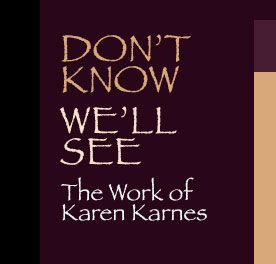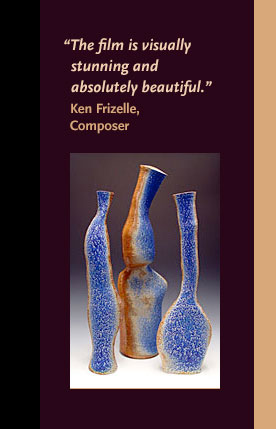



From the beginning of human history, when the earth itself was still sacred, vessels were made of clay and used to cook food as a sacrament of nourishment. Much in contemporary culture is devoid of this connection with the earth and what is sacred, yet people yearn for it. What does a grounded life of creative expression look and feel like in today’s world? It is difficult to find, even among the most committed of artists in any medium, someone whose work is an unbroken rhythm with her life. Karen Karnes is such an artist. The constancy, the slow and even pacing, the focus and simplicity of her life are the context of her art…which comes not from her head, not from her ambition nor even from experimentation. Her work grows organically from her body and from her life. She has been working nearly every day for over 50 years and her work continues to have a strength, a quiet grace and year by year an astonishing newness.
The principal filmmaker, Lucy Massie Phenix, has been a friend and photographer of Karen Karnes since the late 1960’s when they were neighbors in the same artists’ cooperative community in upstate New York. In l997 filming began where Karen and her partner Ann Stannard live in northeast Vermont. The following spring, during the firing of the large wood-fired kiln, her home and studio burned to the ground. Alan Dater and Lisa Merton of Marlboro, Vermont came to film the next day, when the kiln was the only structure left. Surrounded by rubble, Karen opened the door of the kiln to reveal the luminous pieces inside.
After the fire, Karnes has experienced the first interruption in her work since she began working in clay. She says, “The continuity was lost. For two years I’ve been searching for the next step. It’s amazing that I’ve never had a time like this before, when my work didn’t just flow into the next phase. Whatever I do next has to come from the inside. Time will let it happen.” It is in this fallow time that the filmmakers are looking with the artist at the past, the space between and the time ahead.
The film accompanies Karen to some of the natural places that have inspired the sense of mystery in her sculptural work. There are interviews with several lifelong friends, with Mikail Zakin, ceramic educator and artist, and with Paulus Berensohn, dancer, author of Finding One’s Way with Clay and leader of seminars in Deep Ecology. Archival photographs from the 1940’s and ‘50’s trace Karen’s development at Brooklyn College, Black Mountain College and the artists’ Gatehill Cooperative Community in Stony Point, New York. We see her in a major retrospective exhibit at the Garth Clark Gallery in New York in 2003, and at a yearly gathering with the community of potters that she helped to organize 30 years ago when she started The Art School at Old Church Benefit Show and Sale in Demarest, New Jersey.
Yet the words in Don't Know, We'll See are sparse, a reflection of the world in Karen’s studio. Key sequences are the beautiful images of Karen Karnes’ work through the decades of her artistry, the visual representations of the continuity with our deepest and earliest impulses to make form out of spirit.

